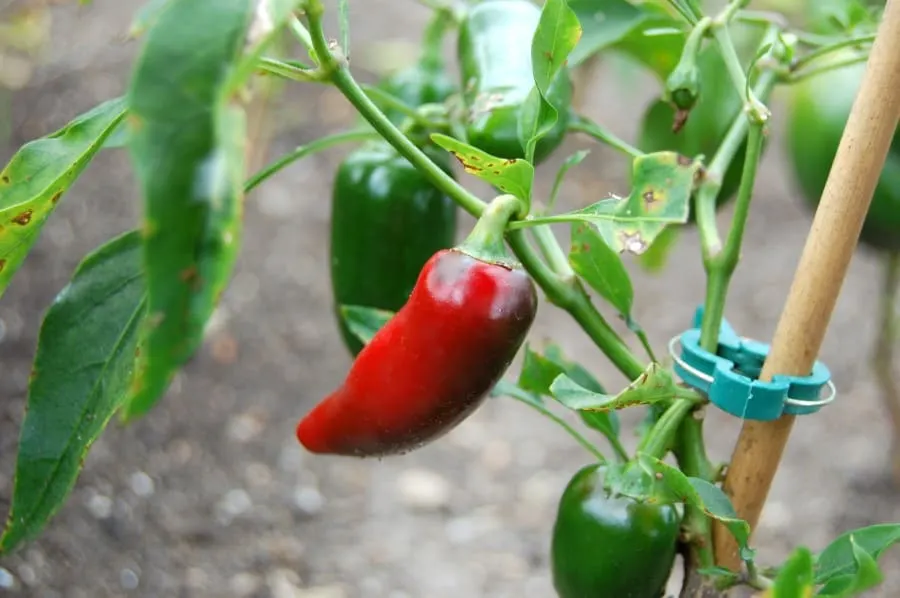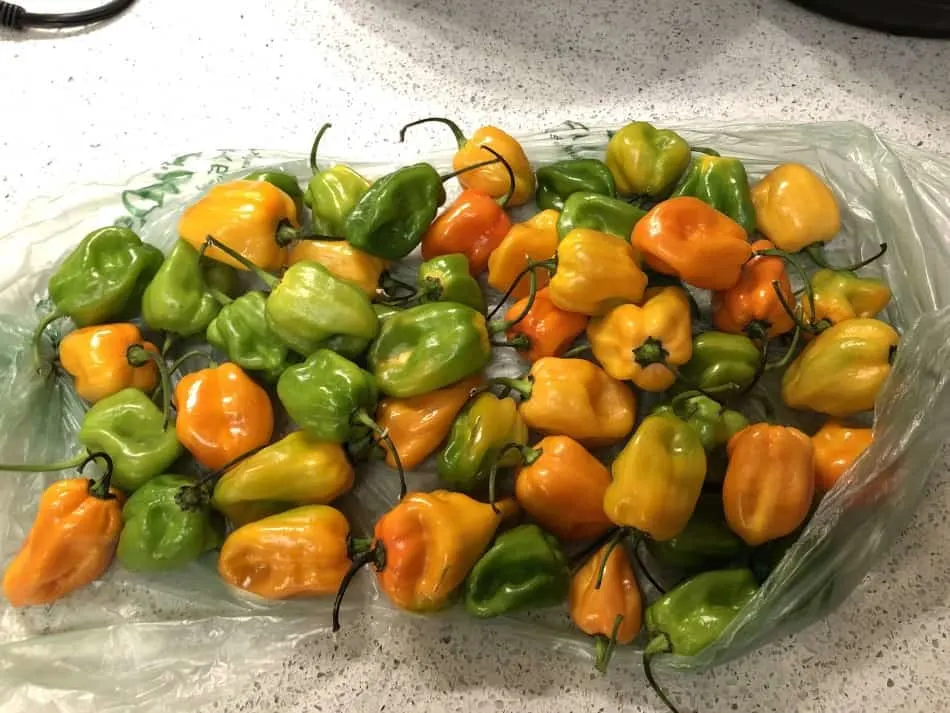Whether it is weather, harvest, or culinary related, if you enjoy peppers and are growing them at home, there may come a time when you will need to speed up their ripening process. Understanding how to ripen peppers will help you determine which method of ripening peppers is best for you.
To ripen peppers on the vine, optimize the soil’s nutrient load and the plant’s environmental conditions, which enhance fruit development and lead to faster ripening. To ripen peppers off the vine, use a paper bag and keep the peppers in warm temperatures to facilitate the creation of ethylene gas.
This article will cover proven techniques that you can use to ripen your peppers on and off the vine. We will also explain why each method works so that you become a more knowledgeable gardener.
The Benefits of Fully Ripening Peppers

The full maturation cycle to achieve full ripeness on the vine for most peppers is 65 to 75 days. Most common pepper varieties grown in home gardens—Bell peppers, Jalapeños, Anaheim peppers, etc.—can be harvested and eaten before full ripeness without any issue.
Eating peppers in their “green” state is quite common. However, nutritional and flavor benefits come with eating a fully ripened pepper instead of a pepper approaching ripeness. Fully ripened peppers tend to be sweeter and have higher levels of vitamins A and C as well as beta carotene.
Three Methods for Ripening Peppers on the Vine
Ripening peppers on the vine requires you to optimize the peppers’ maturation process while still attached to the plant. There are three ways to accomplish this.
Accelerate Natural Pepper Ripening
The ripening of peppers follows the natural maturation cycle of your pepper plant. While there is nothing that you can do to change the timing of this, there are ways to ensure that nothing hinders this process. In other words, your goal is for your peppers to ripen naturally free of interference. Accelerated ripening is essentially curtailing delays in the natural ripening process.
The process starts with choosing your planting location. You want your pepper plants to be in an area where they will receive sufficient sunlight and not be blocked by other plants that may cast shadows or block the sun. If your pepper plant is getting too much sun use some shade cloth to give it some relief.
Additionally, you want to space your plants sufficiently from each other so that they receive enough water and nutrients from their surrounding soil. Your pepper plants should be 10 to 15 inches (25 to 37.5 cms) away from each other. If you plant multiple rows of peppers, each row should be at least two feet (61 cms) apart.
Propper Nutrition for Quicker Ripening
To improve your peppers’ chances of ripening naturally on the vine in the fastest amount of time possible and within their natural maturation cycle, you need to ensure that the soil is in peak condition. In terms of pH, peppers prefer soil with a pH level of 6 to 8.
Before planting, you should fertilize the soil bed with a fertilizer containing nitrogen, phosphorus, potassium, and magnesium. When your pepper plants begin to blossom, you should add ammonium sulfate fertilizer to give your peppers the boost they need to ensure rapid ripening on the vine.
Ammonium sulfate could burn your pepper plants and their root structure if placed too close. It is best to apply it six inches from the base of your pepper plants.
Prune Pepper Plants to Concentrate Resources
Proper pruning will allow your pepper plant to concentrate its resources on producing larger fruit faster. Pepper plants should be bottom pruned to keep their branches at least six inches (15 cms) off the ground. Doing so helps to keep potential pathogens and insects from readily invading your plant. It also focuses more nutrients on the fruit-producing activity of the plant.
Another time pruning can help ripen peppers while on the vine occurs when the planting season is coming to an end. If you are two to three weeks away from the first frost, pruning all of the stems and foliage from your pepper plant, except for those branches that still have fruit, can accelerate the ripening of the remaining fruits.
Four Methods for Ripening Peppers Off the Vine

If you need to harvest your peppers before they have fully ripened on the vine, there are ways to ripen them off the vine.
Windowsill Ripening Method
The windowsill method for ripening peppers off the vine relies on providing two essential factors that promote ripening: heat and sunlight.
Optimal ripening takes place in temperatures above 70 degrees Fahrenheit (21 degrees Celsius). Simple place your peppers on a sunny windowsill and they will begin to ripen. The whole process should take under a week.
When using this method, make sure that the peppers do not dry out by being overexposed to direct light.
Brown Paper Bag Ripening
What is known as the brown paper bag ripening method should more accurately be known as the ethylene method. Ethylene is a fruit ripening hormone released naturally by plants that facilitate the ripening process.
To expedite an off-the-vine pepper ripening process, place the pepper in a brown paper bag with a tomato or banana. It is vital to select a tomato or banana that is in the ripening stage itself, not one that is already ripe. When fruits have already ripened, their ethylene levels drop tremendously.
By sharing the closed space in the bag with a ripening fruit, the pepper will be exposed to higher concentrations of ethylene, which will, in turn, spur its own ripening process. If using this method, make sure to keep the bag at room temperature or slightly higher.
Branch Ripening Technique
The branch ripening technique requires you to cut the branch from your plant containing the unripe peppers. You then bring the branch indoors and hang it upside down where it is in a warm environment. Alternatively, if the outside temperatures are still warm, hang the branch outside.
This method is very similar to the windowsill method, where warmth and sunlight help ripen the peppers. However, the fact that they are still attached to a branch means that the peppers continue to receive residual nutrients from their parent plant.
This technique should only be used at the end of the growing season and if you intend not to overwinter your pepper plants, as removing fruit-bearing branches in this manner will reduce the plant’s vitality.
Countertop Ripening
The countertop method of ripening peppers is best suited for peppers that have already started changing from a green to a red color on the vine. This method is as simple as allowing your peppers to rest on a counter or in a pantry at room temperature or slightly higher.
The countertop method is the most passive method for off vine ripening. It is well-suited for those gardeners who harvest their peppers later in the maturation cycle.
It is also useful to those who bulk harvest their peppers in a single session. It allows you a no-hassle method that allows your harvest to continue to ripen before you use them or store them for later through freezing or canning.
Keep in mind that the countertop method will not be effective at ripening fully green peppers into fully ripened red peppers. The peppers must be partially ripened for the countertop method to work.
Closing Thoughts
Peppers can be ripened while on the plant as well as after being picked and taken indoors. While on the plant, peppers ripen faster if the plant is healthy and has received proper amounts of water and nutrients from the soil.
Off the vine, keeping your harvested peppers warm or exposing them to ethylene, the fruit ripening hormone, will result in ripened peppers in a period ranging from a few days to two weeks.
